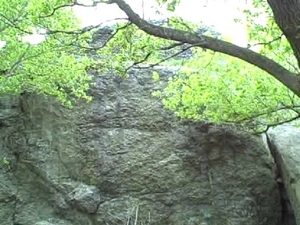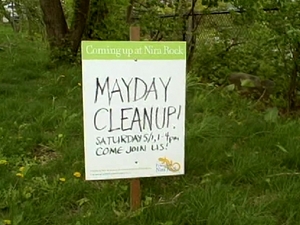
Urban Wilds present unique benefits and challenges
By Ned Prickett
4/30/10
Boston's Urban Wilds
The City of Boston owns 41 urban wilds, varying in size from as little as one acre to 100 acres.
While they are green spaces that can often be used by the public at least passively, urban wilds are not parks.
"They are the fragments of natural Boston that remain today," explained Paul Sutton, coordinator of open space and special projects for the city of Boston's parks department. "They encompass all different types of habitats like coastal marshes, salt marshes, meadows, forested wetlands and rock outcroppings."
Urban wilds provide habitat for native plants and animals and play an essential ecological role. They help filter urban run-off, help reduce flooding, ease the warming effect of urban development, and improve air quality.
Despite the important role urban wilds play, the city's program lacks funding. While Sutton said that there is a small amount of capital money available for critical things like safety issues, the majority of the program is funded by grant money and relies on community and volunteer involvement. Sutton is actually the only Boston employee who works with the wilds, and due to a recent shift in his duties, it has become more of a "half-time" duty.
"The (urban wilds) are largely supported through a huge network of volunteers," Sutton said. "We partner with neighborhood groups, corporate groups non-profit groups, and academic institutions."
One of the groups that has partnered with the city to help with the urban wilds is the Boston Natural Areas Network. The BNAN was organized in 1977 and works with Boston communities to preserve, expand and improve open spaces throughout the city.
"Even though they are city-owned properties and they are part of the parks department they are not a part of their budget," said Karen Chaffee, BNAN's stewardship manager. "They are very neglected."
The BNAN sponsors activities in the wilds to try to build an appreciation for what the unique properties have to offer. Sponsoring events like nature walks and other educational programs as well as summer youth work crews, BNAN hopes to engage and involve the community in protecting these unique ecological treasures. The reality is that many urban wilds are not used and the smaller wilds in more urban areas can often be or perceived to be unsafe or dangerous.
"Many people feel really nervous about wooded areas where there isn't lighting," Chaffee explained. "When there is no presence from law enforcement, often they are used as spaces by people for drinking or dealing. There are a lot of people who don't use them unless there is access or unless there is a clear presence that people are taking care of the space."
Because urban wilds vary so greatly in make-up, size and location, they require different approaches. Sutton said for the small and urban wilds, it is all about making people feel safe.
"They need to be conceived as welcoming, safe places," Sutton said. "For a lot of Bostonians and urban residents in general who aren't that familiar with natural areas, they need to be treated a little bit differently. A lot of it is making them feel safe. Managing the vegetation, making sure that the entrances are clearly demarcated and that the sight lines in and out of the site are good."
 Nira Rock
Nira Rock
Nira Rock in Jamaica Plain is an example of a small urban wild in the heart of a Boston neighborhood. Only encompassing 1.5 acres at the end of Nira Avenue- a sleepy dead end street- the site used to be a crime hot spot.
"There were both serious addicts using and there were people selling back here," Christine Oliver, founder of Friends of Nira Rock said. "It wasn't even people from the community. It was like this known drug destination."
The friends group started as an offshoot of the neighborhoods crime watch. Oliver was going to meetings to report the growing issues and decided to partner with other concerned citizens that were coming to the meetings to form a group that would try to improve things.
The group got in touch with Paul Sutton, who at that time was the urban wilds manager for the city of Boston. The neglected site called for a unique approach.
"We treated it a little bit more with design than we would have with other sites," Sutton said. "For example, clearly demarcating a pathway system, entrances and peeling back some of the vegetation."
COG Design created a design plan and starting in 2005 Friends of Nira Rock began to implement changes that have turned the site from a practically abandoned space to an open and inviting natural habitat.
Nira Rock is a unique wild because it has two distinct areas. There is a lower area, called the orchard, which is distinguished by a 40-foot high wall of puddingstone. Following a trail, around the face you can walk up to the top area called the meadow. The new design called for work on both areas of the wild.
The group removed diseased trees and planted low-maintenance native species in the orchard and with a small changes grant was able to link the site with Jefferson Playground, which is next to Nira Rock, to make the space more open and inviting.
"We are trying to have high plantings and things that are low so you can see into the site," Oliver said.
In the meadow, the group removed a large, man-made burn of building debris and had the land recontoured to its original contour.
"We planted a low-growth grass because we were finding stolen purses and syringes and things like that," Oliver said."
The efforts have paid off, according to Oliver.
"It's moving from a few intrepid people with dogs to a lot more people enjoying it," she said. "People will bring their small children and picnic here. No one would have done that 10 years ago."
The friends are still trying to get the word out to the community that there is a unique space to enjoy.
They have sponsored rock-climbing clinics with BNAN and in the summer they show movies on the rock face. They have had 30-40 people show up to watch a film.
And while the goal is to make it an open and inviting place for the community Oliver said the friends are always trying to find the right balance.
"There is the real combination where we want people to feel comfortable but there is a real focus on it being habitat," Oliver said. "It's not a park so it is maintained by people from the community. It is a habitat. Parks are too, but this is really something where we are keeping a balance when we are thinking about what kinds of activities we want to have here, how much use and what kind of use."
Other Challenges
But Nira Rock and other urban wilds like it are just one type.